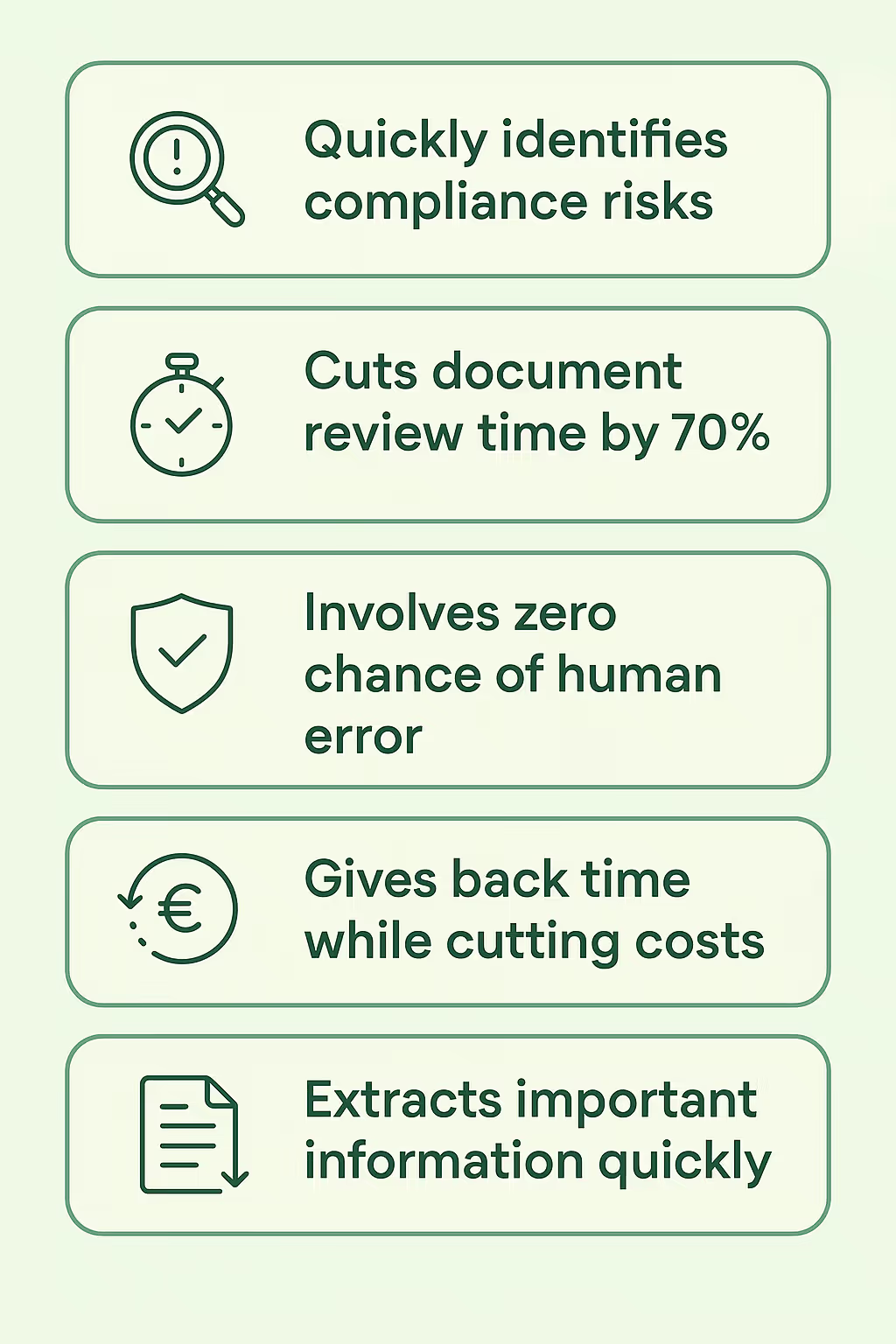(Updated on 29th May, 2025)
Gone are the days when due diligence meant endless hours poring over documents, with the constant threat of human error looming overhead. Modern AI is transforming how we approach complex tasks across industries, including due diligence. With AI's capability to process and analyze large data sets rapidly, what used to take days or weeks can now be accomplished in a fraction of the time.
Also read: Free Step-By-Step Guide to Developing an AI Use Policy
This shift isn't just about speed; it’s about enhancing accuracy and opening up new possibilities for in-depth analysis without attorneys stuck racing against time.
In this blog post, we will explore how AI is revolutionizing due diligence, making the lives of legal professionals easier and their work more efficient and precise.
What does AI-powered due diligence do?

AI due diligence involves leveraging AI technology and machine learning to support and shorten the due diligence process during Mergers and Acquisitions (M&A) deal preparation and execution.
When asked about which stage in an M&A transaction they are most likely to use AI, a staggering 56% of lawyers picked due diligence. And then there’s the 87% of lawyers who agree that AI tools for reviewing contracts and documents will soon become standard in the M&A due diligence process.
More research suggests that AI could reduce the time taken to perform due diligence from several months to less than a month.
But how? What does AI actually do during the due diligence process?
#1 Quickly identifies compliance risks
Since AI excels in sifting through documents, it can identify compliance issues and potential risks quickly. Automation works to reduce the time-consuming process of manual review.
Also read: What is AI Contract Compliance?
#2 Cuts document review time by 70%
AI algorithms are also capable of analyzing vast amounts of data rapidly. This speed and depth of analysis enable more informed decision-making. AI not only cuts down the labor-intensive work junior attorneys perform, but also enhances the quality and thoroughness of document analysis. Think of this process as AI-driven QA. It’s not foolproof, but it’s mighty helpful.
AI's ability to process information directly translates to time savings. For instance, AI can reduce traditional due diligence document review time by up to 70% on average. This can help you uncover critical provisions across thousands of documents in mere minutes and limit the need for repetitive tasks.
#3 Involves zero chance of human error
Human error is inevitable, but AI can change that. You get accurate and reliable outcomes with an AI due diligence process in real time. AI models aren’t infallible, though. They can make mistakes driven by poor data and bad training. Using the right model for your needs can limit mistakes.
#4 Gives back time while cutting costs
The efficiency and accuracy of AI lead to substantial cost savings. It reduces the time spent on due diligence and helps legal teams conduct more accurate reviews at a reduced cost and in a shorter time frame.
“The ROI of AI will be heavily fact-dependent for each organization based on what AI tools the department wants to utilize, the amount of customization needed, the number of users, and so forth. But of course, over time, as adoption increases and Moore’s Law takes over, the power of AI will increase and the costs will come down, probably dramatically within the near future.”
~Sterling Miller, CEO of Hilgers Graben PLLC
#4 Extracts important information quickly
AI's advanced analysis capabilities can uncover hidden insights that might otherwise go unnoticed. You can simply prepare a list of questions to ask AI after it has read or analyzed the document.
These questions could range from “What are the important numbers and cost figures from the document?” to “Can you find any anomalies in the document?”
Also read: Alternative Legal Careers for Lawyers: 20 Realistic Ideas
Tools and tech that support AI due diligence
To successfully incorporate AI into your legal operations, you’ll need to find a solution that understands the intricacies of legal data and fits seamlessly into your existing legal workflow. Seek AI tools that are specifically designed for legal applications. These tools should be adept at analyzing legal documents, understanding legal jargon, and identifying legal issues.
What to look for in a tool
A good AI tool for legal teams or freelance lawyers has a minimal learning curve—the focus should be on leveraging the tool's capabilities rather than figuring out how to use it. The tool should also have:
- A user interface that is intuitive for legal professionals
- Minimal technical knowledge requirements to operate
- A user-friendly dashboard that allows easy access to key features and data for enhanced efficiency
Since different M&A transactions involve a range of documents, from financial statements to employee contracts, the chosen AI tool should be versatile enough to handle various types of data and document formats. This includes PDFs, Word documents, and spreadsheets. Moreover, it should be capable of extracting data from these diverse sources accurately. Your chosen AI tool needs to parse through and interpret the nuances in contracts, legal filings, and compliance documents.
The AI tool should easily integrate with your team’s current legal management software and databases. This integration is crucial for ensuring a smooth transition and continuous workflow. For instance, if your team uses a particular CRM, the AI tool should be able to integrate with it, allowing for the seamless transfer and analysis of data.
SpotDraft's capabilities
Tools like SpotDraft AI are designed by legal experts to extract and analyze key information from contracts and legal documents. SpotDraft AI can answer questions about batches of contracts in plain English, giving instant insights.
Compatibility
SpotDraft offers compatibility with a wide range of software applications commonly used in business operations. Whether you're using CRM systems like Salesforce or HubSpot, project management tools like Jira and Slack, or electronic signature solutions like DocuSign or Adobe Sign, SpotDraft ensures smooth integration and seamless data exchange.
Customization Options
SpotDraft seamlessly scales to accommodate your business's growth at every stage. This tool is customizable to your specific needs. SpotDraft is also scalable and easily accommodates the growing and changing needs of your legal department.
SpotDraft’s minimalistic dashboard keeps your most important data front and center. You can filter contracts, find the latest version, and even check what stage it’s in. Try this end-to-end platform crafted to evolve with your needs.
Data Security
Given the sensitive nature of legal work, SpotDraft is built with cutting-edge security and compliance in mind, so your sensitive data and contracts are always safe and secure. This tool meets the highest standards of data security and complies with relevant data protection laws. These robust security measures protect confidential information.
Review and Reputation
SpotDraft has a premier reputation in the market. The SpotDraft reviews and case studies that demonstrate effectiveness in legal settings.
Check out the SpotDraft review below and review more here!
“SpotDraft streamlines our workflows so we can focus on true legal requests, not the repetitive general requests that can be resolved via standard fallbacks and appropriate approvals. Everything simply works, the team is open to feedback, and the team is constantly improving the product!”
– Taylor Smith, Contract Manager, PostScript
Due diligence checklist for legal teams
Incorporating AI into the due diligence process can be a game-changer. However, to truly harness its potential, you must approach its implementation strategically.
Fortunately, we've gathered the information you need into a checklist to help you effectively integrate AI into your due diligence toolkit.
#1 Identify your AI objectives
This step involves understanding the specific challenges your team faces and how AI can address them. These could include:

#2 Ensure high-quality data
AI tools rely heavily on the quality of data they process. High-quality data is the fuel that powers AI engines, enabling them to generate accurate and insightful outputs.
Here's a more detailed look at how you can ensure the quality of your data:
- Start with a thorough audit of your existing data. Review and verify the accuracy of the data in your repositories. Inaccurate or outdated data can lead to misleading AI analyses. Consistency in how data is formatted and stored is also crucial. Ensure that all documents and data follow a uniform structure to facilitate easy data analysis.
- Organize your data repositories for ease of access and navigation. This might involve categorizing data into specific folders or databases, such as contracts, financial records, legal documents, and correspondence.
- Perform data cleaning by removing duplicates, correcting errors, and filling in missing values. Preprocessing may also include converting data into formats compatible with your AI tools, such as digitizing paper documents or converting files into machine-readable formats.
- Establish a routine for regular data maintenance. This includes updating data repositories with new information, removing obsolete files, and reorganizing data as necessary. Keeping your data fresh and relevant ensures that your AI tools have the latest information to work with.
- Integrate data systems to create a centralized view. If your data is spread across different systems or platforms, data integration allows for a centralized view of all relevant information, making it easier for AI tools to access and analyze data from multiple sources.
- Prioritize data privacy and security from the start. Ensure that your data handling practices comply with all relevant data protection regulations and implement robust security measures to safeguard sensitive information.
Also read: In-House Legal Guide to Safeguarding Company Data
Note: To ensure safe use of AI in your organization, you could benefit from an AI use policy. Here’s how to create one.
#3 Integrate AI smoothly into existing systems
The AI tool you choose should integrate well with your current systems and software. This minimizes disruptions and ensures your team can adapt to the new tool with minimal learning curve.
Here's how you can integrate AI into your tech stack:
- Integrate with your existing legal management software. Before selecting an AI tool, consider compatibility with current databases and workflow tools. Like we mentioned before, the AI solution should be compatible with the technologies you currently use.
- Engage your IT department or tech support team from the outset. Their technical expertise is invaluable in assessing the compatibility of the AI tool with your current systems and in managing the integration process. They can help identify potential technical issues and work on solutions to ensure a smooth transition.
- Consider a phased approach to integration. Start with a pilot program or a specific department before expanding to the entire legal team. This approach allows you to iron out any kinks and make necessary adjustments before a full-scale deployment.
- Keep the lines of communication and support open throughout the integration process. Regular updates and open discussions with your legal team and IT support can help manage expectations and address any concerns promptly.
#4 Train your team
Provide training sessions for your team to get comfortable with the new AI tools. Understanding how to use these tools and interpret their output is crucial for leveraging their full potential in due diligence processes.
Here's how you can train your team quickly and efficiently:
- Develop training sessions based on user roles and specific AI tools. For instance, in-house counsel might need in-depth training on interpreting AI-generated analyses of legal documents, while administrative staff may require basic training on data input and retrieval.
- Leverage vendor-led AI training programs when possible. Take advantage of these resources. Vendor-led training can provide comprehensive insights into the tool’s features and best practices for its use.
- Create role-specific training modules. These should address the unique needs and usage scenarios of various team members. For example, senior attorneys might focus on using AI for strategic insights, whereas paralegals might use it for document organization and retrieval.
- Develop a repository of training resources. This includes guides, FAQs, tutorial videos, and best practice documents. Make these resources easily accessible for team members to refer to as needed.
- Encourage team exploration of AI tools beyond the basic functionalities. This exploration can lead to discovering innovative ways to use the tools specific to your team’s needs.
Key legal and compliance risks to evaluate
Teams must use AI tools ethically. This means being transparent about how AI is being used in your processes and being up-front with the legal and compliance risks sometimes associated with AI.
Inform relevant stakeholders, including clients, about the role of AI in your due diligence efforts. Transparency helps build trust and demonstrates your commitment to ethical practices.
Be mindful and prepare for the following:
#1 Avoid Bias
AI systems can sometimes reflect or amplify biases present in their training data. All users must actively work to identify and mitigate this risk. This might involve reviewing the data sets used for training the AI and ensuring they are diverse and representative. Regular audits of AI outputs for potential biases are also crucial.
#2 Preserve human decision-makers
While AI can provide valuable insights and recommendations, human legal professionals should always make final decisions. Ensure that your team understands that AI tools are there to assist, not replace, their judgment and expertise.
Cory Lamz, VP Legal of Buoy Health, puts it best: “AI can be a tool in your toolbox that can help support decision making, but it shouldn't make the decisions.“
Also read: Building relationships with a problem-solving mindset
#3 Keep records and run training
Keep detailed records of how AI tools are used in your due diligence processes. This documentation can be crucial for accountability, and in case any ethical or legal questions arise regarding AI use.
Provide training to your team on ethical considerations in using AI. This includes understanding the limitations of AI, recognizing when and how to question AI outputs, and being aware of the potential legal and ethical implications of relying on AI.
These two actions go a long way to protect your team and company during a compliance audit.
Also read: 6 steps to write a generative AI use policy
Embracing the future with AI-enhanced due diligence
The integration of AI in legal due diligence marks a significant leap forward. AI brings a new level of efficiency and insight, transforming the traditionally arduous due diligence process into a faster, more precise, and insightful practice.
As we look to the future, AI's role in legal due diligence is set to expand, becoming an integral part of legal teams’ toolkits. For legal professionals ready to embrace this change and lead the way in technological adoption, exploring AI solutions like SpotDraft legal hub is a step toward the future.
SpotDraft AI offers the advanced capabilities and user-friendly experience you need to stay ahead. Try SpotDraft AI and be a part of this transformative journey.


.avif)







